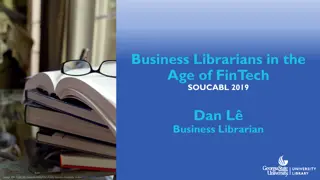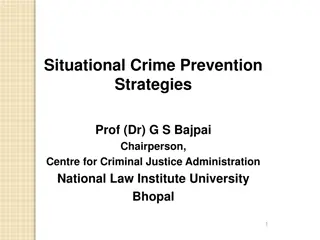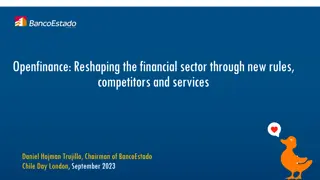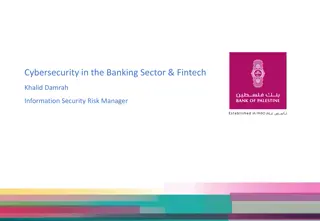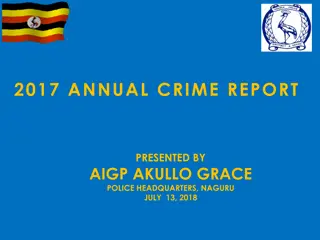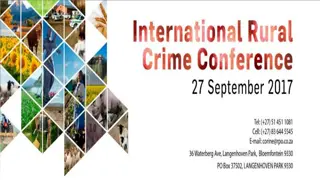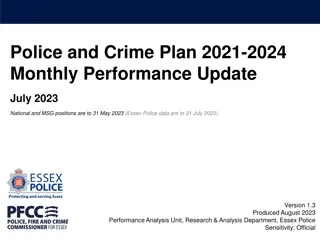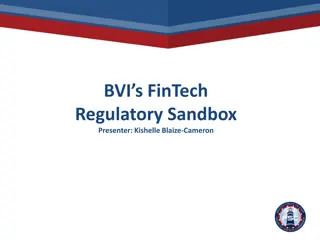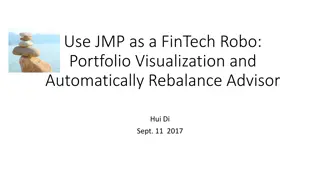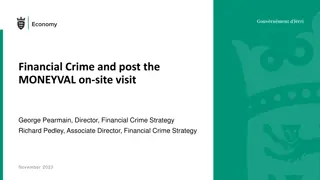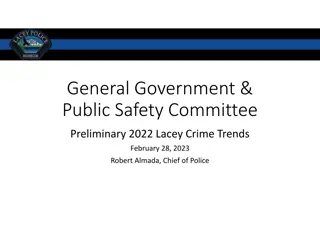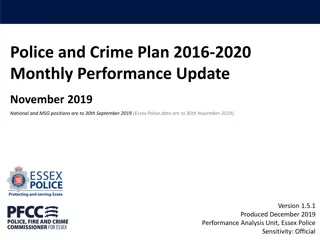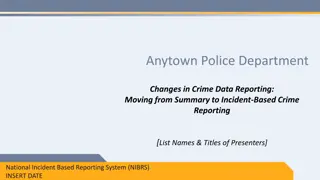Emerging Trends in FinTech Solutions for Financial Crime Prevention
Explore the latest FinTech trends in fighting financial crime, covering global regulatory agendas, industry challenges, and future outlooks post-pandemic. Delve into topics like sustainable finance frameworks, technology advancements for supervisory capabilities, and current regulatory responses to the COVID-19 pandemic.
- FinTech Solutions
- Financial Crime Prevention
- Regulatory Landscape
- Sustainable Finance
- Technology Advancements
Download Presentation

Please find below an Image/Link to download the presentation.
The content on the website is provided AS IS for your information and personal use only. It may not be sold, licensed, or shared on other websites without obtaining consent from the author. Download presentation by click this link. If you encounter any issues during the download, it is possible that the publisher has removed the file from their server.
E N D
Presentation Transcript
Spotlight on FinTech Trends in Financial Crime Now, Next and Beyond A Future Global Outlook
Introduction LaNishka McSweeney Kristin Burt Partner & MLRO Assistant Director & Compliance Officer EY Region of The Bahamas, Bermuda, British Virgin Islands and Cayman Islands EY Region of The Bahamas, Bermuda, British Virgin Islands and Cayman Islands
Agenda Now: A look at the 2021 global regulatory agenda Industry pain points FinTech trends Next and beyond: What to expect from the post-pandemic regulatory landscape Appendix: Key FinTech profiles
Now: A look at the 2021 global regulatory agenda
Now: A look at the 2021 global regulatory agenda The COVID-19 pandemic response Terms that are now commonplace in regulatory discussions - forbearance, compassionate collection, and business interruption. As firms transition from crisis management they should anticipate and prepare for an increase in complaints, regulatory and political scrutiny and potential legal action. Sustainability Renewed worldwide regulatory pressure for adoption of sustainable finance frameworks and growing support for the agenda from large international banks, investors and corporates. Regional and national efforts are underway, and we expect to see further momentum throughout the year. For example, Singapore and Hong Kong have been driving disclosure and taxonomy initiatives in APAC. The Monetary Authority of Singapore (MAS) is developing standards for insurance, banking and asset management sectors, and the Hong Kong Securities and Futures Commission (HKSFC) has issued proposals for climate risk disclosure by fund managers and with other regulators and is starting on a sector-wide taxonomy to be aligned with the EU and Chinese efforts.
Now: A look at the 2021 global regulatory agenda Technology and data Regulators will want to renew efforts to transform supervisory capabilities through the expanded use of technology and data. The UK Financial Conduct Authority s (FCA s) digital regulatory reporting (DRR) initiative is already moving ahead via various pilots and proof of concept exercises. Artificial intelligence (AI) and machine learning (ML) regulatory frameworks are developing fast in APAC and the EU, focusing on fairness and transparency. Prudential risk Regulators will be focused on supervisory stress testing and banks own internal stress testing as a means of testing the asset quality of banks and understanding capital vulnerabilities. The European Central Bank (ECB) intends to retain temporary capital relief measures until the end of 2022 and retain temporary liquidity relief until the end of 2021 at least. Similar extensions will apply in APAC and the US.
Now: A look at the 2021 global regulatory agenda Operational risk Remote working: Banks will need to demonstrate how they are able to maintain effective controls in a WFH environment. Some supervisors have already expressed concerns that monitoring of staff and controls around trading and customer interaction are showing signs of weakness. Digital operational resilience: Financial services firms can expect more regulatory attention on a cross-sectoral basis to their digital operational resilience framework, including (i) development of more integrated, consistent and detailed regulations, (ii) digital operational resilience testing, and (iii) oversight of critical third-party providers, including cloud outsourcing. Concentration risk in the delegated supply chain Alarming, we re hearing of global shortages for Christmas, with US Presidents calling in largest logistics firms Amazon, Google, etc to discuss backlog, in UK England faced gas shortages and expects supply chain disruption in EU due to shortage of truck drivers. These challenges can present risks and opportunities for banks as they seek to diversify their risk
Now: A look at the 2021 global regulatory agenda Digital finance Smaller economies are welcoming alternative business and virtual assets BVI licensed first bank providing digital banking services Cayman Islands Virtual Asset Service Provider Act, regulations and guidance Bermuda licensing digital asset businesses Cryptocurrency: Increased presence in the Caribbean while China outlawing crypto and other governments considering bans STX recently moved to The Bahamas El Salvador adopted Bitcoin as legal tender Central Bank Digital Currency (CBDCs): Countries are starting to issue their own digital currency Bahamas Sand Dollar Eastern Caribbean DXCD (protype being tested) Marshall Islands SOV Cambodia Bakong Sweden E-krona
Financial firms are facing challenges from multiple fronts in tackling financial crime Legacy issues Limited Budget Lack of consistent approach and standards Poor data quality Financial crime accounts for US$1t to US$3t in annual activity globally, yet less than 1% is detected due to highly manual processes FinTech players lack robust cyber resilience due to budgetary limitations, adequacy and availability of skilled resources together with the necessary technologies Anti-money Laundering (AML) professionals are dealing with poor data quality which sits at the core of the compliance screening problems they face on a daily basis There is no consistent approach followed by the regulators in providing guidelines to the FinTechs FinTechs with limited banking activities are not yet in scope of regulatory initiatives or supervision. Limited data availability on FinTechs restricting regulators to monitor and report on FinTech trends Increased need to provide additional context to the generation of false positives by revamping the traditional platforms due to growing transaction volumes Lack of budget resources to clean up historical data or handle manual errors
To help the firms tackle these challenges, FinTechs are collaborating, building capabilities and leveraging emerging technologies Building capabilities leveraging emerging technology Forming Ecosystems Collaboration for Knowledge sharing FinTech players are developing proprietary platforms for open exchange of information and application-based solutions between the industry users and the solution providers Regulators and industry experts are working hand in hand to achieve the growth of the FinTech sector and improvements in financial crime compliance FinTechs are adopting emerging technologies to address the onslaught of financial crime risks They are focusing on the rapid deployment of AI, machine learning, and intelligent automation towards AML and KYC This will facilitate sharing of best practices that will strengthen the sector s ability to detect and counter financial crime effectively The ecosystem provides a holistic approach to combating financial crime providing a single view of customer risk profile
FinTechs collaborating to form an ecosystem NICE example With increasing complexity in fraud and crime, industry players are turning to collaboration to tackle financial crime. Some of the leading FinTechs are partnering to build an ecosystem which allows Financial Institutions (Fis) to create custom solutions leveraging technology from any participating FinTech. The ecosystem brings together best-in-class solutions from different players enhancing the defense against financial crime. NICE has formed its own marketplace X-Sight Marketplace which is an open data and application sharing platform that acts as a nexus between innovative data software and solution providers like Jumio, InAuth, X Daon and the FIs. Jumio joined NICE Actimize providing advanced AI and biometrics to improve ID and identity verification and meet KYC requirements for FIs Boku brought its expertise in end-to-end identity solutions to NICE Actimize s X-Sight Marketplace ecosystem Zenus Bank accelerated transition to the cloud with NICE Actimize Anti-Money Laundering and Fraud Essentials
Industry stakeholders are collaborating towards knowledge sharing FinTech FinCrime Exchange (FFE) FINTRAIL and the Royal United Services Institute (RUSI) have created a knowledge-sharing forum where financial crime typologies are being discussed in the UK. It also launched FinTech FinCrime Exchange (FFE) in the United States. FFE comprises 90+ FinTechs globally. It brings together a global network of FinTechs to collaborate on best practices in financial crime risk management. They engage in ongoing information sharing in the pursuit of common understandings, frameworks, standards, and consultancy approaches to prevent financial crime Some of the other objectives include - pursuing uniform technology standards and security safeguards for data systems and improving collaboration between law enforcement agencies from throughout the world FINTRAIL has FinTech participants like Monzo, U Account, Coinfloor who have collaborated to share insights, industry best practices and published whitepaper in the financial crime space
Industry stakeholders are collaborating towards knowledge sharing FinTech knowledge hub European Banking Authority has established an information-sharing hub where industry best practices are exchanged between traditional banks and the FinTechs The European Banking Authority (EBA) Knowledge Hub will ensure that EU supervisors share best practices and adopt a technologically neutral approach to the application of new technologies in the financial sector. This will help facilitate innovation and scalability across the financial crime space
FinTechs are creating niche solutions leveraging emerging technology to drive effectiveness, efficiency and experience Enhance the customer experience Increase the effectiveness of solutions leveraging AI and ML Streamline the process to improve efficiency Tech players have developed digital KYC utilities using artificial intelligence and machine learning to enable the industry to collectively address the global compliance challenge by allowing users to manage and share due diligence information Automation of complex AML, screening, transaction monitoring and alerts processes, leveraging AI and robotic process automation (RPA) to improve the efficiency of the overall financial crime detection and prevention process (for example Ayasdi) Some FinTechs are using machine learning to improve effectiveness by reducing false positives: Players like Tookitaki and Feedzai are building intelligent decision support systems (DSS) to help combat money laundering and terrorist financing Fenergo has streamlined KYC compliance for financial institutions There are increased alliances of RegTech and FinTechs to combat money laundering, automate customer monitoring with KYC and due diligence tools and screen payments in real-time using blockchain and other proprietary RegTech solutions (e.g., TruNarrative, a FinTech partnered with Regtech ComplyAdvantage) Some others are leveraging advanced analytics techniques such as network analysis and behavior analytics to identify suspicious patterns and unravel potential fraud Banks, with the help of Feedzai, saw a 70% increase in customer onboarding without a corresponding increase in fraud losses Improve data quality using AI: AML professionals struggle with poor data quality; hence improving data quality will increase the effectiveness of AML solutions
In the process, four complementary models of collaboration among FinTechs have emerged
Next and beyond: What to expect from the post-pandemic regulatory landscape
Next and beyond: What to expect from the post-pandemic regulatory landscape Policy evolution and strategy In Europe, the EC has published an updated Capital Markets Union (CMU) action plan, which seeks to bolster market financing, reduce over-reliance on bank financing, and address COVID-19 impacts. The CMU plan contains policy objectives that will resonate globally, such as the search for a greener economy with broader capital markets that deliver more lending across all sectors while addressing conduct issues with a focus on retail customer outcomes. In the US, it now looks likely to focus on supervision of systemically important financial institutions, consumer protection and financial inclusion, sustainability, implementation of public support measures and housing finance reform. Sustainability On top of the initial building blocks of taxonomy and disclosure, another milestone will be the integration of climate and sustainability considerations by financial institutions when investing on behalf of or advising clients. Financial inclusion Post-pandemic priorities may mean that the inclusion agenda may take longer to progress. Ultimately, a key objective is likely to be, via policy development and collaboration between regulators and industry, that markets and institutions deliver financial services to all market participants
Next and beyond: What to expect from the post-pandemic regulatory landscape Anti-money laundering (AML) Increased cross-border cooperation and proposed regional bodies such as an independent, stand-alone EU AML agency, will play an important role, but the architecture will be crucial to counter the speed and ingenuity of the criminals. We can expect to see some groundwork being laid on convergence via collection of national standards and intelligence sharing. The US has already passed the first major revision to Bank Secrecy Act (BSA) and AML requirements in two decades, clarifying and streamlining the rules, adding new regulatory requirements, and expanding the scope of a covered entity. Digital finance Coherent digital strategies being developed: EU digital finance package, which prioritizes licensing, AI/ML retail payments, cryptocurrency/assets, and digital operational resilience. Singapore has launched a coordinated digital program linking also to green finance. Cryptocurrency: Developments in cryptocurrency will include a heightened response from regulators as they seek to manage the risk posed by cryptocurrencies and payment systems that lie outside the supervisory framework. Central banks will accelerate efforts to deliver digital currencies (CBDCs) that they hope will form the foundation of national payment systems.
Next and beyond: What to expect from the post-pandemic regulatory landscape Prudential risk Regulators will want to address some of the contagion effects in financial markets arising from either non-regulated or significantly less-regulated entities, whether via Big Tech or other forms of non-bank financial intermediation (NBFI). Regulators may consider: Extension of oversight and ensuring current non-regulated participants have sufficient liquidity to manage their own stresses. Lower-key liquidity stress testing of funds in the non-bank sector in order to avoid concerns about the potential contagion falling back into the banking system. Emergence of a dual stress-testing framework as the norm: a macro-economic scenario-driven framework; and a broader and far-reaching events-driven framework.
A recurring theme across the post-pandemic regulatory landscape will be the need for supervisors and standard setters to identify and collect new, standardized data sets that can inform policymaking that allows the new frontiers of technology, sustainability and ESG to expand while maintaining appropriate levels of resilience and risk sensitivity.
Appendix Key FinTech Profiles


